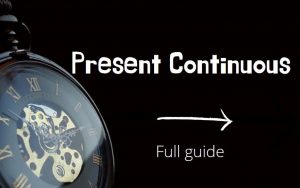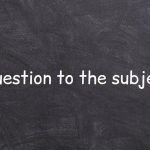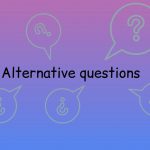Why should everyone start learning English grammar with the Present Simple? Because the Present Simple is one of the most important tenses in the English language. Also, the Present Simple is one of the easiest tenses.

Why do we need the Present Simple?
Using the Present Simple, you can tell a story, tell about yourself and your hobbies, what you do often and what you like. Using the Present Simple, you can ask a question or ask someone for help.
The Present Simple can be used to describe:
- Simple, common actions.
- Habits or hobbies.
- Regular actions not related to the time of speaking.
- Facts or known truths.
- Transport timetables.
- Instructions or recipes.
But the most important thing is that after learning the Present Simple, you can start speaking in English! Because the Present Simple shows you the most important basic grammar principles.
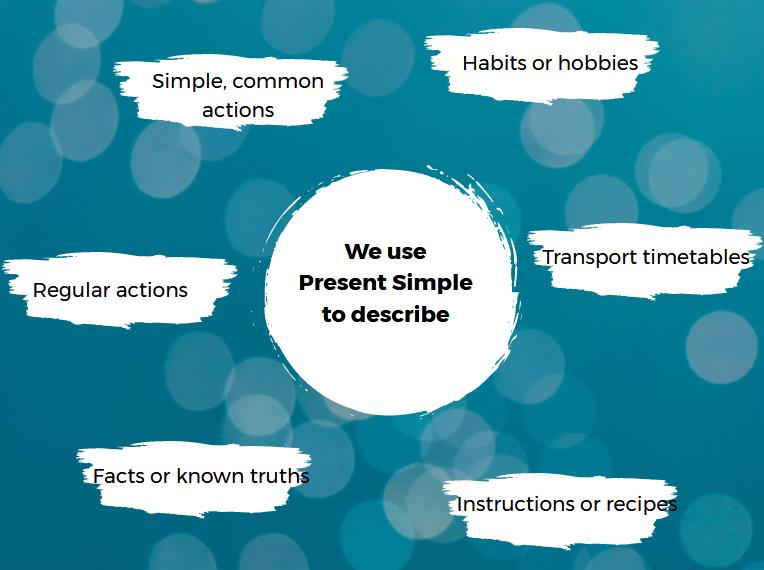
How to form sentences
The Present Simple is probably called Simple for a reason. After all, its form is very simple. We need to know just a few basic rules so that we can form a statement, question, or negation.
How to form Affirmative (Positive) Sentences in Present Simple
To make an affirmative (positive) sentence in the Present Simple we need two main components:
- Subject (who or what performs the action)
- Main verb
I play football.
We see in this example that the subject is “I” and “play” is the main verb.
Jessica loves to dance.
We see in this example that the subject is “Jessica” and “loves” is the main verb.
To form an affirmative (positive) sentence, we need the subject. After the subject, we put the main verb in the base form. The base form looks the same as the infinitive (to see, to talk, to jump) but without the to.
If you have forgotten, the infinitive form of a verb looks as we see verbs in dictionaries:
- to love
- to look
- to go
- to do
- to speak
If you remove the “to” they turn into:
- love
- look
- go
- do
- speak
These are the base forms of the verbs.
The base form is how we use the verb after the subject in the Present Simple for all persons, except the third-person singular (he, she, it).
If we use a verb with the third-person singular, we need to make another change with the verb. We add the -s or -es endings.
We add the -s or -es endings to verbs in the Present Simple according to the following rules:
Rules for how to add the -s ending to the verb
Rule 1: If the verb ends with a vowel, then we add the -s ending to the verb:
- Love -> Loves
- Donate -> Donates
- Make -> Makes
Rule 2: If the verb ends in -sh, -ch, -s, -x, -o, then we add the -es ending:
- Pass -> Passes
- Do -> Does
- Push -> Pushes
- Fix -> Fixes
Rule 3: If the verb ends with -y preceded by a consonant, we must change the “y” to “i” and then add the -es ending.
- Fly – Flies
- Cry – Cries
- Study -> Studies
- Worry -> Worries
- Try -> Tries
Take a look at the examples of how the endings of verbs change depending on the subject:
To dance.
- I dance
- You dance
- He dances
- She dances
- It dances
- We dance
- They dance
To watch.
- I watch
- You watch
- He watches
- She watches
- It watches
- We watch
- They watch
To try.
- I try
- You try
- He tries
- She tries
- It tries
- We try
- They try
How to form Negative Sentences in Present Simple
We can form a negative sentence in the Present Simple in two ways:
- Using the auxiliary verbs do/does + the negative not.
- Using negative pronouns and adverbs.
Let’s take a closer look at these two methods:
Negative sentences with do not / does not
To form a negative sentence with the auxiliary verb do, we must add the negative not. Thus, we get do not.
do + not = do not (don’t)
do not is the construction we need for a negative sentence.
We need to put do not after the subject (Who? What?) but before the main verb (love, want, watch, play, jump, etc.).
Example:
I do not like it.
| I | the subject |
| do not | shows that this is a negative sentence |
| like | is the main verb in its base form. |
More examples:
I do not work.
We do not play football.
They do not know the answer.
This rule applies to all persons except the third-person singular (He, She, It).
Remember that for the third-person singular (He, She, It) we add the -es ending to the auxiliary do.
do + -es = does
Let’s add the negative not to does.
does + not = does not
We can use does not in negative sentences in which the subject is the third-person singular.
It does not work.
John does not like candy.
This dog does not bark.
IMPORTANT: Please note, when we form an affirmative (positive) sentence in the third-person singular, we add the -s or -es endings to the main verb.
She likes candy.
However, in the negative sentence, we do not add the -s or -es endings to the main verb. We add -es to the auxiliary verb do.
She does not like candy.
In negative sentences, we do not add -s or -es to the main verb, because we have already added this ending to the auxiliary do + -es = does.
She does not like candy.
We don’t need -s at the end of the main verb because that ending has gone to the auxiliary verb do already.
What is the Short form of do not / does not?
The full forms do not or does not are rarely used in English. Most often, we use the short form of these auxiliary verbs:
- Do not – Don’t
- Does not – Doesn’t
Examples:
I do not love you.
I don’t love you.She does not read books.
She doesn’t read books.
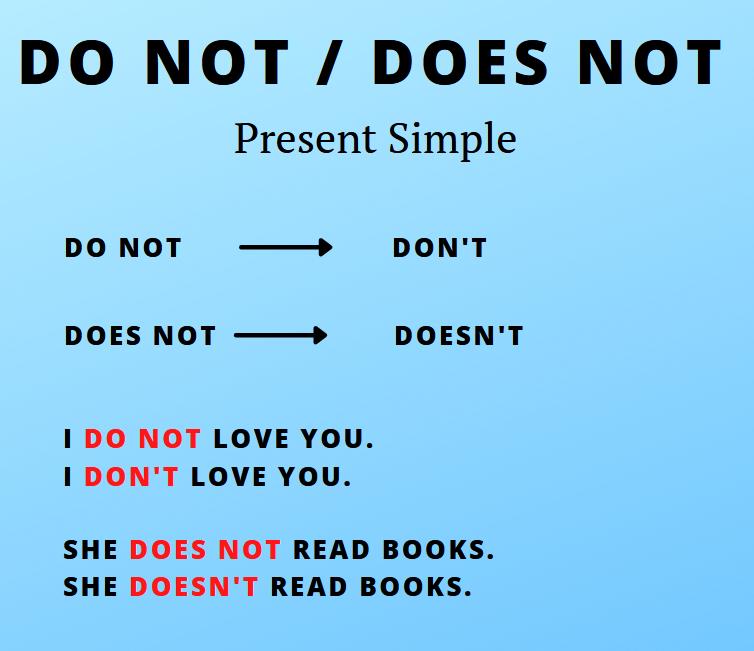
How to form Negative sentences with negative pronouns and adverbs
We also can form a negative sentence in the Present Simple using negative pronouns or adverbs.
Some popular negative pronouns are:
- no
- nothing
- nobody
- no one
- none
- neither
- nowhere
Some popular negative adverbs are:
- never
- scarcely
- hardly
- barely
This method is easier to understand than the previous one.
Because we don’t need auxiliary verbs to form negative sentences with negative pronouns or adverbs!
Negative pronouns or adverbs already contain a negative meaning.
Examples:
John sees no one.
I never read books.
Jessica hardly believes you.
She runs nowhere.
We think nothing.
In these sentences, we do not need to use the auxiliary verbs don’t or doesn’t, because these sentences are already negative because of the words such as: never, hardly, nowhere, nothing.
Note that in such negative sentences, we add the -s ending (or -es) to the main verb if the verb comes after the subject in the third-person singular.
Correct: She runs nowhere.
Incorrect: She run nowhere.
Incorrect: She run nowheres.
Important: We do not use the negative auxiliaries don’t or doesn’t in such sentences because otherwise, we have a double negative! Double negatives are not common in English.
Correct: I do not love you.
Correct: love no one.
Incorrect: I don’t love no one.
Incorrect: I don’t newer love you.
How to form Interrogative (Question) Sentences in Present Simple
To ask a question in the Present Simple, we put the auxiliary verb do before the subject. If the subject is the third-person singular (he, she, it) then instead of do we use the auxiliary verb does.
In an interrogative (question) sentence, do or does is always placed before the subject! The subject should be followed by the main verb (the base form of the verb: love, want, watch, play, jump, etc.).
Example:
Do you sing?
As you can see, asking questions is very easy!
Take a look at additional examples of interrogative (question) sentences in the Present Simple:
Examples:
Do you know what this means?
Does he still come to you?
Do they really need our help?
Do you know what he wants?
Does he look okay?
Do they see everything I do?
How to form Special Wh questions
In addition to General or Yes/No Questions there are also Special or Wh-Questions.
We ask Special questions in order to find out some additional information.
Such questions contain additional question words, for example:
- what
- where
- which
- why
- when
- who
- how
This is why this type of question is called Wh-Questions. Because most often such words start with -wh.
- which
- why
- when
What do we use special questions for?
For example, imagine that we have a friend Max. We want to know if Max reads books. We can ask him a usual, general question:
Do you read books?
Max can answer this question with Yes or No.
But what if we want to know what kind of books Max reads? The words what kind are additional question words. Because we want to clarify what kind of books Max reads.
What is the formula of a Special or Wh-Question? The formula looks like this:
Question word (or phrase) + auxiliary verb + subject + main verb
What books do you read?
What is a question word.
do is the auxiliary verb.
you is the subject.
read is the main verb.
We can use not one but several words or a whole phrase to ask a special question. It depends on what kind of information we are interested in.
What books by English writers do you read?
The main thing to remember is that a special question looks exactly the same as a general question, only you need to put a question word or phrase in front of the auxiliary verb.
Examples:
What do you think of this car?
How do you go to work?
Who does he see?
What book do you want to read?
What sound do they hear?
Which pizza does he like?
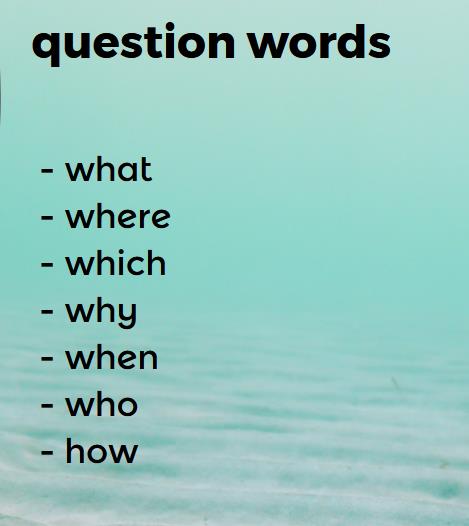
How to Answer Questions in Present Simple
In English, there are different types of answers to questions.
Of course, we can use the simplest way by saying just YES or NO. This is how we can answer a simple general question.
Question: Do you like this movie?
Answer: Yes.Question: Do you know this person?
Answer: No.Question: Does Jessica love Max?
Answer: Yes.
But this is the easiest way to answer a question. Yes or No can even be said by someone who does not speak English at all.
We need to learn not the simplest but grammatically right way to answer a question:
Short answer in Present Simple
- A short positive or negative answer with the auxiliary verbs do or does.
When we use do or does in answers, we kind of replace the verb from the question with that. What does it mean? Let’s see an example:
Question: Do you like this movie?
Answer: Yes, I do.
In this case, the answer “Yes, I do” should be understood as “Yes, I like it.”
do = like
Yes, I do = Yes I like it.
Instead of saying, “Yes, I like it,” we usually say “Yes, I do”. The verb do in the answer replaces the main verb in the question.
Question: Do you see him?
Answer: Yes, I do.
The main verb in this question is the word “see”, then the answer “Yes, I do” means “Yes I see”.
For a negative answer, we need to use the word no at the beginning, plus we add the negative not to the auxiliary verb do / does.
Question: Do you see him?
Answer: No, I do not. (do not means do not see)Question: Does she like this movie?
Answer: No, she does not. (does not means does not like)
Full answer in Present Simple
To form a full positive answer, we need to use the word yes and repeat the question itself in the affirmative (positive) form of the Present Simple. Without using interrogative (question) words.
Let’s take a question as an example:
Do you read books in English?
We are throwing out the interrogative (question) auxiliary verb do from this question. We add yes to the beginning of the sentence. This is how we get a full affirmative (positive) answer:
Answer: Yes, I read books in English.
More examples:
Question: Do you like this movie?
Answer: Yes, I like this movie.Question: Does this dog bark loudly?
Answer: Yes, this dog barks loudly.
If we want to form a full negative answer, we need to use the word no at the beginning of the answer and repeat the question in the negative form of the Present Simple without using interrogative (question) words. For example:
Question: Do you like this movie?
Answer: No, I do not like this movie.Question: Does this dog bark loudly?
Answer: No, this dog does not bark loudly.
The verb To Be
The verb to be is special in English. The verb to be has its own unique rules. Therefore, we form positives, questions, and negatives with the verb to be in Present Simple according to special rules. These rules are different from the rules we apply to other verbs.
IMPORTANT: We do not use any auxiliary verbs with the verb to be in the Present Simple. The verb to be can form positive, question, and negative sentences on its own. We do not use the verb do/does or don’t / doesn’t.
The verb to be in the present simple has three forms that depend on the subject in the sentence.
- I am
- He is
- She is
- It is
- We are
- They are
- You are
You are my best friend!
My mom is a teacher at school.
They are funny guys.
Therefore, in order to correctly use the verb to be in the Present Simple, we must choose the appropriate form depending on the subject.
To form a Positive sentence, we put the verb to be after the subject.
I am your friend.
They are respected residents of our city.
This is some kind of strange object …
To form a question, we put the verb to be before the subject.
Am I weird?
Is she your sister?
Is this your home?
Are they students from your school?
In a negative sentence, we add the negative not.
I am not the writer you are looking for.
They are not students from my school.
My mom is not a doctor.
You can read the full article about the verb to be in present simple.
The verb To Have
Why are we talking about the verb to have separately? Because the verb to have is a special verb.
The verb to have in the present simple has two forms – have and has. The form of the verb to have depends on the subject.
- I have
- He has
- She has
- It has
- We have
- They have
- You have
In British English, the verb to have is often used with the particle got.
I have a new car.
I have got a new car.
More often than not, have or have got mean the same.
Now let’s see how we form positives, negatives, and questions with to have and to have got.
To have.
An affirmative sentence with to have looks exactly like a regular affirmative sentence in the Present Simple. The main thing is to choose the correct form of the verb to have, depending on the subject.
I have some work to do this evening.
She has a large family to feed.
We have a client with us right now.
We form an interrogative (question) sentence with to have using the auxiliary verb do/does. The form of the verb to have itself does not change and remains as have.
Do you have something on your mind?
Does she have any brothers or sisters?
Do they have a Japanese menu for me?
To form a negative sentence, we also use the auxiliary verb do or does and the negative not.
I don’t have money…
She doesn’t have any friends.
They don’t have time to speak with you.
Please note that when we form questions or negatives, the verb to have does not change its form and remains as have for all persons. That is, we do not use has even with the pronouns he, she, it. This is because when we form questions and negatives, we use the auxiliary do, which changes to does in the third-person singular.
Correct: Does she have any brothers and sisters?
Incorrect: Do she have any brothers and sisters?
Incorrect: Do she has any brothers and sisters?
Incorrect: Does she has any brothers and sisters?
To have got.
To form a positive sentence with have got, we simply choose the correct have or has form depending on the subject.
We have got some money.
I have got one or two shirts to hang out.
He has got a bad headache.
We don’t use auxiliary verbs to form a question with have got. We just put have or has in front of the subject, and the particle got after the subject. Thus, have or has serves as an auxiliary verb.
Has she got a stomach ache?
Has he got a girlfriend?
Have you got an alternative suggestion?
In order to form a negative sentence, we also do not use any auxiliary verbs. We just add the negative not after have or has and then we add got.
I have not got anybody to play with!
I’m afraid we have not got any spare cash.
She has not got much to laugh about, she is a poor woman.
When we use Present Simple
Present Simple is a very popular tense in English. There are many cases where we use it.
- We use the Present Simple when we talk about common knowledge. About what is always true. This may be a well-known truth:
Elephants live in India.
Stars shine in the sky at night.
Monkeys eat bananas.
Or it may be only true for us personally:
This boy is my son.
I like my job.
I have a large and comfortable house.
- We use the present simple when we make general statements:
Children love ice cream.
A wedding is a joyous day in a person’s life.
- When we talk about regular, repetitive, habitual actions.
I wake up at six in the morning every day.
We go to our country house every weekend.
- When we describe actions that take place one after another.
I wake up early in the morning, brush my teeth. After that, I read the morning news.
- Or when we tell a story.
I hear some noise, go out into the yard and see that there are three raccoons in the trash can. The raccoons see me and quickly run away.
- Also, with the help of a present simple, we talk about our or someone else’s skills or abilities. Often, in this case, we use modal verbs:
I can swim well.
John does different tricks on the skateboard.
My children are fluent in three languages.
- Present simple is used in recipes or instructions:
Pour two cups of water into a saucepan, boil the water and add three tablespoons of sugar and one spoonful of salt. Then put two cloves of garlic in a saucepan …
Place the pump on a flat surface, connect the hose to the pump.

You could also read How to Use Present Simple for the Future
Present Simple and the Zero and the First conditionals
We use the present simple in the first and the zero conditionals. To understand why the present simple is ideal for use in such cases, let’s see why we use the first and the zero conditionals.
- We use the Zero Conditional when we mean a condition that is always true.
- We use the First Conditional when we want to express a real condition.
The Present Simple expresses obvious facts or something that is always true. Therefore, the present simple is ideal for such sentences.
You’ll get soaked if you go out in this rain.
If you go slower, you’ll see much more.
If you sell the cow, you sell her milk too.
If he goes one step further with this crazy idea, I’ll resign.

Time Clauses
We use the Present Simple in Time Clauses that start with:
- until
- as soon as
- when
if the action in the sentences refers to the future tense.
How to form Time Clauses with Present Simple?
The first part of the sentence begins with the words when / until / as soon as followed by the Present Simple.
The second part of the sentence is formed using Future Simple, this part describes the result:
Take a look at examples:
As soon as you ask me, I will give you this book to read.
When Jessica calls you, you will tell her the whole truth.
Until I see John, I will not do anything.
We may swap parts of such sentences. The main thing to remember is that we must use the Present Simple in the part of the sentence that begins with the words When / until / as soon as. We must use Future Simple in the second part of the sentence, which shows the result.
Take a look at examples where we swapped the parts:
I will give you to read this book as soon as you ask me.
You will tell her the whole truth when Jessica calls you.
I will not do anything until I see John.
What are Markers of Present Simple?
The Present Simple has its Markers. The words that help identify this tense.
We can divide the Present Simple Markers into two parts:
- Adverbs (regularly, often, never)
- Time Pointer (at the weekend, twice a week)
Look at the List of commonly used markers:
- never
- usually
- regularly
- always
- often
- seldom
- rarely
- from time to time
- sometimes
- twice a week
- three times a week
- every day
- every week
- every month
- every year
- Every ten years
- Five times a year
- Once a week
Examples of sentences in Present Simple with markers:
I drink tea every morning.
Jessica is rarely late.
I often walk in the park.
John watches TV sometimes.
We play football twice a month.
Our family travels to Hawaii every year.
I leave work at six o’clock in the evening.
She wakes up at dawn.

Present Simple Examples
Look at examples of the sentences in Present Simple. Try to understand what rules we used in those sentences.
I watch TV every day!
Jessica is very rude to her friends.
I don’t like this book!
We are the best students in our school.
The bus leaves at six o’clock in the evening.
I wake up every morning at 8 o’clock, and on weekends I like to sleep long.
She loves pizza.
Do you love me?
I do not want to talk about this topic.
Do you know the answer to this question?
Max is the best player on our team.
She is jealous of her friend!
He never comes on time.
I don’t talk to strangers.
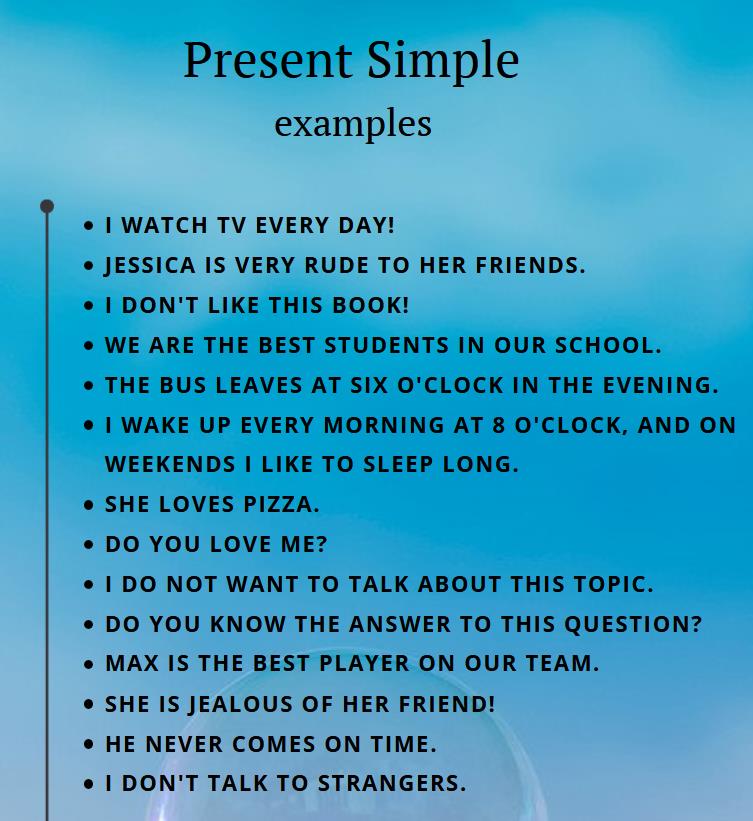
Afterword
The Present Simple is one of the most useful parts of English grammar. The Present Simple is a fairly simple topic to learn. But after learning this topic, you can start speaking English, understand simple texts, video, and audio. You will also understand the basic rules by which all English tenses are formed.
Hello! If you would like to thank me for the articles I wrote, you can click Buy me a coffee. Thank you! ❤❤❤


